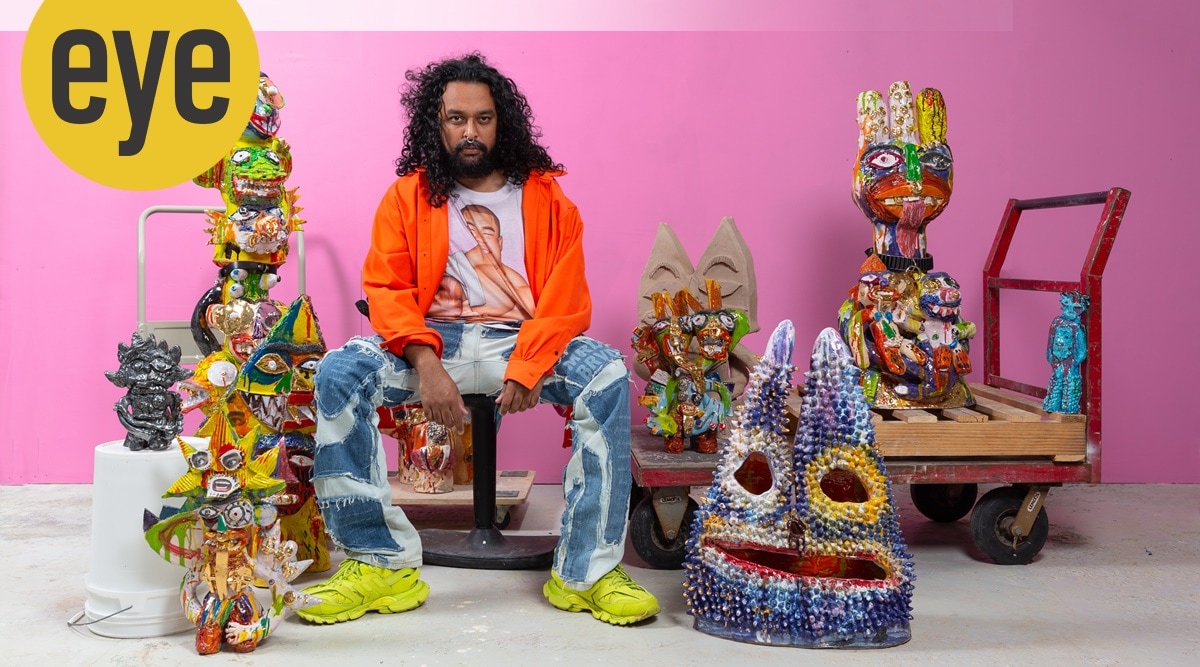 Ramesh Mario Nithiyendran (Courtesy: Jessica Maurer)
Ramesh Mario Nithiyendran (Courtesy: Jessica Maurer) Ramesh Mario Nithiyendran’s sculptures are as colourful as the world’s deadliest mushrooms. They smile like Cheshire Cats. Embellished with a profusion of spikes, limbs, penises, lips, breasts and heads. Everything about them spells danger. But, instead of walking away from these feral mutants, we are drawn to them. It doesn’t even matter whether we like them or not. They tug at something primal and instinctive, earning our curiosity and teasing our desperation to understand.
The Australian sculptor is having his first solo show in India, which opened earlier this month at Mumbai’s Jhaveri Contemporary and is slated to run till March 26. “The language of my work sometimes can have a lot of darkness but I wanted this show to be hopeful and energetic and bright and fresh,” says Nithiyendran, 33, over a phone call. Titled “The Mud and The Rainbow”, the exhibition comprises 14 ceramic pieces that primarily explore sculptural archetypes, such as fertility figures and tutelary spirits. It’s a mash-up of civilisations and iconographies — figures sit like a Buddha, resemble Mesoamerican masks, rise like totems and have multiple heads like Hindu gods. Within this tableau, Nithiyendran manages to convey ideas of queerness and digital culture.
Fertility figure (2021), which the artist describes as “open, queer and fun, as a kind of anchor for the exhibition” is a crowned being carrying two smaller zoomorphic figures, as if they were infants. One ape-like and the other porcine, the progenies’ heads double-up as the nurturer’s breasts. Nithiyendran says, “I want to allow audiences an opportunity to bring their knowledge of historical sculptural tropes.” The sculpture recalls the Mother Goddess archetype, of which figurines were made through millennia and also hints at Christian representations of the Madonna and Child.
There is also Double horned spiky blue head (2021), a cartoonish animal face (Nithiyendran did grow up loving Disney movies) that could well be a cat, a rabbit, an upturned tooth or a jackfruit. Another work is Multi-coloured head (2021), which, in its rejection of classical marble busts, recalls monolithic statues such as the Moai.
 Ramesh Mario Nithiyendran’s Fertility Figure (2021)
Ramesh Mario Nithiyendran’s Fertility Figure (2021) Nithiyendran is among the significant artists to emerge from Australia in recent years. With more than a dozen solo shows and commissions to his name, and several more group shows, his works have been featured at the National Gallery of Art in Canberra, the Dhaka Art Summit, and the Indian Ceramics Triennale in Jaipur. There is global interest in his pantheon of gender-fluid polychrome sculptures but also in his origin story. He was born in Colombo, Sri Lanka, to a Tamil Hindu father and a Dutch Burgher mother. Before he could turn one, the family fled the war-torn country to safer shores in Sydney, where Nithiyendran continues to be based. Though he was baptised, he found the imagination of Hindu temples and the polytheism of Hinduism more appealing. Though he is an atheist, he plays with religious iconographies.
“The Mud and the Rainbow”, for instance, has differently sized works, some toylike. “They are like effigies, which I remember seeing in a temple as a child,” he says. A totemic Warrior figure with headpiece (2021), evokes the Ayyanar who guards village and temple boundaries in South India and Sri Lanka. The Ayyanar typically smiles, but as a tiger might, with exposed fangs. Nithiyendran says, “The massive teeth and wide eyes, that sense of hyperbole plays into my work. These expressions are like emojis, which are heightened symbols. I try to work with expressions that are almost hard to place. That for me is what makes them interesting, that inability to grasp what they were feeling if they were sentient.”
Among Nithiyendran’s notable guardians is Double-faced avatar with blue figure (2021), in the HOTA Gallery collection in Gold Coast, Australia. It was his first outdoor sculpture—a six-metre-high stick figure that nods to cave art and memes, to the past and the present. It has that same unsettling mix of the Ayyanar grin and the grimace emoji. Nithiyendran says, “The thing about teeth and the tongue…I am uninterested in ideas of passively-accepted social grace. These figures are to the side of social convention.” When Double-faced avatar with blue figure opened at HOTA Gallery, Nithiyendran recalls that not everyone got it. He says, “A lot of the responses were that it was demonic, evil…But the sculpture was a welcome gesture.” In the recorded history of the world, grotesque guardian figures are meant to ward off evil and mark a safe space, be it a Medusa head, a dvarapala of Buddhist temples, demonic faces painted on ash gourds in South India, or even the mascarons of Art Nouveau architecture.
Nithiyendran’s sculptures come at a time when there is a global movement to rethink memorials to exploitative leaders and events. He says, “In the context of 2021, [they ask] Australia to look towards Asia and the Pacific for references to public sculpture as opposed to colonial monuments.” While the sculptor has not set out to be political, his sculptures offer more inclusive aesthetics with which to view public art. They also question the idea of boundaries—do they welcome or threaten? With the right commissions, it will be interesting to see how Nithiyendran’s sculptures interact with public spaces in South Asia, given that tutelary figures are often outdoors, surrounded by ritual and ceremony, right among the people they protect.
- The Indian Express website has been rated GREEN for its credibility and trustworthiness by Newsguard, a global service that rates news sources for their journalistic standards.

